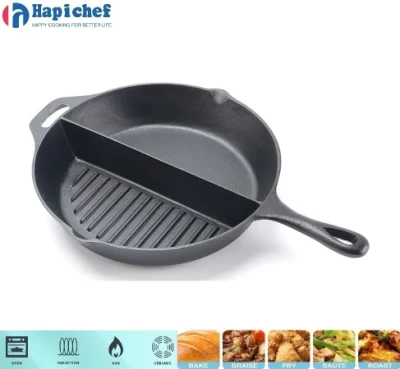Exploring the Production Process of Cast Iron Pans in Modern Manufacturing Facilities Today
The Art and Science of Cast Iron Pan Manufacturing
Cast iron pans are beloved kitchen staples, known for their durability, heat retention, and versatility. The production of cast iron pans is a fascinating blend of traditional craftsmanship and modern technology, involving several meticulous processes that transform raw materials into the iconic cookware cherished by chefs and home cooks alike.
The Raw Materials
The primary ingredient in cast iron pan manufacturing is iron ore, which is typically derived from iron-rich minerals. Other essential components include carbon and various alloying elements, such as silicon and manganese. The manufacturing process begins with mining iron ore, which is then smelted in a blast furnace to produce pig iron. This pig iron is further processed to adjust the carbon content and produce the desired quality of cast iron, which typically contains 2-4% carbon.
The Molding Process
Once the cast iron is prepared, the next step is to create molds. Traditionally, sand casting is the method of choice in foundries. This process involves creating a mold from a mixture of sand, clay, and water. Molds are crafted from patterns, which can be either wooden or made of metal. Each mold is carefully designed to shape the pan, with intricate details that dictate its final form, including the handle and cooking surface.
The sand mixture must be compacted with precision to ensure that it maintains its shape during the pouring of molten iron. After the mold is made, the pattern is removed, leaving a hollow cavity that will take on the shape of the cast iron pan.
Melting and Pouring
a cast iron pan factories

The next critical step is melting the cast iron. This involves heating the raw cast iron in a furnace until it reaches its molten state, typically around 1,200°C (2,192°F). The molten iron is then poured into the molds, filling the hollow cavity and taking the shape of the pan. This process must be executed with care, as any imperfections during this stage can lead to defects in the final product.
After pouring, the molds are allowed to cool and solidify. Once cooled, the sand molds are broken open to reveal the newly formed cast iron pans. This demolding process requires skilled labor to ensure that the pans are not damaged during extraction.
Finishing Touches
After demolding, the pans undergo several finishing processes, which may include grinding, sanding, and polishing. These steps ensure that the surfaces are smooth and fit for cooking. Any rough edges are removed, and the pans are often seasoned with oil to create a natural non-stick surface. The seasoning process involves heating the oil on the pan, allowing it to bond with the iron, creating a protective layer that enhances cooking performance and prevents rust.
For many manufacturers, sustainability plays a critical role in their operations. Some foundries utilize recycled cast iron, which reduces waste and environmental impact. By melting down old cast iron cookware, they can create new pans while minimizing the need for raw materials.
The Final Product
Once the final touches are complete, each cast iron pan is subjected to quality checks to ensure they meet industry standards. This involves checking for surface imperfections, weight consistency, and overall finish. Pans that pass inspection are then packaged, ready to be shipped to retailers or directly to consumers.
In conclusion, the manufacturing of cast iron pans is a remarkable synthesis of tradition and innovation. Each pan produced carries with it the legacy of craftsmanship, showcasing the dedication and precision involved in creating this timeless cookware. Each cast iron pan is not just a cooking tool; it is a piece of art that embodies the skill and passion of those who create it, ready to deliver culinary excellence for generations to come.
-
Why Every Kitchen Needs a Casserole Cast Iron DishNewsJun.24,2025
-
Experience the Tradition and Quality of Cast Iron CookwareNewsJun.24,2025
-
Double Sided Cast Iron Grill PanNewsJun.24,2025
-
Cast Iron Dutch Ovens You’ll Actually UseNewsJun.24,2025
-
Buy Cast Iron Griddle for Everyday CookingNewsJun.24,2025
-
Barbecue Iron Grill Cooking PowerNewsJun.24,2025
-
Standard Product Lines from Cast Iron Cookware SuppliersNewsJun.11,2025
